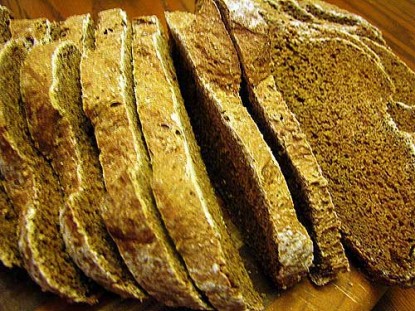
Pumpernickel is a combination of rye and wheat, and, often, all-purpose flour (for a lighter pumpernickel), with coloring and flavoring including molasses, chocolate or cocoa, and sometimes even coffee. My Grandmother Bread pumpernickel includes molasses, cocoa, and enough all-purpose flour–-but not too much-–to keep it both light and sturdy. It’s a great dinner bread as well as perfect for sandwiches.
Difficulty: Intermediate
Servings: varies
Prep Time: 2 hours Cook Time: 30-35 minutesIngredients
1 1/2 cups warm water
1 teaspoon yeast
1/2 teaspoon salt
1 tablespoon white or brown sugar
1/3 cup molasses
1/3 cup cocoa
1 teaspoon caraway seeds (optional)
3 tablespoons homemade dough enhancer (recommended)
1 cup rye flour
1/2 cup whole wheat flour
1 1/2 cups (approximately) all-purpose flour
cornmeal for dusting
Directions
Start with the standard one-loaf version of Grandmother Bread: 1 1/2 cups of water, 1 teaspoon yeast, and 1/2 teaspoon salt. You’re going to use a bit less sugar (and you can use brown sugar instead of white, if you choose), then the pumpernickel add-ons, which are the molasses, cocoa, rye and wheat flours, and caraway seeds (optional).
Find out more about Grandmother Bread here.
Get the homemade dough enhancer recipe here.
In a large bowl, combine water, yeast, salt, sugar, and molasses. Let rest five minutes, then add the cocoa. Add the caraway seeds. (You can leave the caraways seeds out if you prefer, though you will lose a bit of the traditional pumpernickel flavor.)
Add three tablespoons homemade dough enhancer (or a store-bought dough enhancer). I highly recommend using dough enhancer for breads using whole grains. It makes a huge difference in the lightness and rise of the loaf.
Stir in rye and wheat flours. You’ll need approximately 1 1/2 cups of all-purpose flour, but go easy! Add 1/2 cup at a time, using a strong spoon, until dough becomes too stiff to continue stirring easily. Add a little more flour and begin kneading. Continue adding all-purpose flour and kneading until the dough is smooth and elastic. (This IS a sturdy dough. It should be pliable but not sticky.) Let dough rise in a greased, covered bowl until doubled. (About an hour.)
Uncover bowl; sprinkle in a little more flour and knead again. With floured hands, shape into a loaf.
Pumpernickel is often traditionally shaped as a free form loaf, usually round with a slashed top. You can also bake it in a loaf pan, or even as rolls. Grease the pan with oil then dust liberally with cornmeal.
Use a knife to slash the top. I like to make a sort of “tic-tac-toe” design on the top.
Often I don’t even give free form loaves a second rise, preferring to put them straight into the oven (with no preheating) to let them rise as the oven heats up then quickly bake. This helps many types of free form loaves retain shape. However, pumpernickel is a sturdy dough–sturdy enough to take a second rise in free form and also sturdy enough to need a second rise to prevent heaviness. Cover loaf and let rise 30-60 minutes.
Bake in a preheated 350-degree oven for 30-35 minutes.
You can also make Pumpernickel Raisin, which is a fabulous toasted breakfast bread!
To make Pumpernickel Raisin: Be sure to use brown sugar instead of white. Omit caraway seeds. Add 1 cup of raisins to the water/yeast mixture and follow remaining instructions in regular pumpernickel recipe.
Categories: Breads, Yeast Breads
Submitted by: suzanne-mcminn on July 31, 2010



 (3 votes, average: 4.33 out of 5)
(3 votes, average: 4.33 out of 5)
Cindy says:
I made this last night and it came out soooo good…It is the first time I’ve ever made Pumpernickel Bread and was quite impressed with the results 🙂 Although I owe it all to your website, I just LOVE your recipes…THANK YOU!!
On December 22, 2010 at 2:12 pm